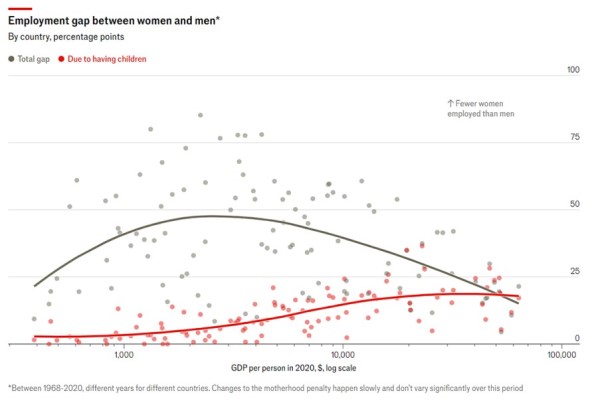How motherhood hurts careers


This article was originally published by The Economist on 30 January, 2024.
“When things are sh**ty we change them”, read a placard held aloft at a “March of the Mummies” protest in Britain in October 2022. “Childcare shouldn’t cost our future”, declared another. The message fell on fertile ground in Westminster: six months later the Conservative government announced plans to expand subsidies for early-years child care. The first of a bundle of measures will come into effect in April.
The cost of child care can be an imposing barrier to work. For many British women it is especially daunting. For one in ten it exceeds their take-home pay, according to a survey of 24,000 parents by Pregnant then Scr**ed, an advocacy group. Only in America, Ireland and New Zealand do child-care costs take up a greater share of parents’ net household income across the OECD, a club of mostly rich countries. But almost everywhere women’s careers suffer after they become parents.
Whereas around the world 95% of men aged between 25 and 54 are in the labour force, the figure for women of the same age is just 52%. Little has been understood about how much of this gap is explained by mothers leaving formal work after giving birth. But a group of academics from the London School of Economics (LSE) and Princeton University has now amassed a trove of data to measure the effect in 134 countries, home to 95% of the world’s population. Building on the work of Claudia Goldin, a Harvard economist who was awarded last year’s Nobel prize in economics for her research into gender inequality in the labour market, the authors compare mothers and fathers with childless people of similar age, education, marital status and so forth. Mothers’ labour-market participation falls after childbirth in almost every country in the study.
The authors define the “motherhood penalty” as the average amount by which a woman’s probability of being employed declines during the ten years after the birth of her first child. On average 24% of women leave the labour force in the first year. Five years later, 17% are still absent. After ten years, 15% are.

Many women in rich countries worry about another problem: being paid less than men. But the two are linked: gaps in employment tend to limit a woman’s lifetime earnings. Being out of work can mean delaying or missing out on promotions and other career opportunities, and can make it harder to find a job.
The effect of motherhood on employment varies widely between countries. In the rich world, 80% of the gap between male and female labour-force participation is explained by women dropping out after the birth of their first child. By contrast, in the poorest countries motherhood explains only about 10% of the gap. There, women tend to leave the labour market upon marrying, usually well before their first child is born. In Mauritius and Zambia, for example, marriage explains nearly half of the participation gap.

In middle-income countries women are more likely to work after they wed, but many quit permanently after becoming mothers. For example, in Latin America, 38% of working women leave the labour force after having a child, and 37% are still out a decade later. As a result, the overall employment gap in these countries is little different from that in low-income ones.
Many mothers leave work because doing so makes economic sense. “There is no point in going back four or five days a week, because I would have about £100 [$127] a month left after child-care,” says Alison Greatorex, a mother in Surrey who has not returned to work since the birth of her two-year-old child. Cultural norms also have an effect. The International Labour Organisation, a UN agency, estimated that in 2018 606m working-age women across the world were unable to consider employment because of family care duties, against only 41m men. In a previous, smaller international study, the LSE and Princeton authors found that women whose mothers stayed at home were more likely to do the same.
With labour markets in the rich world and many other countries tight, many policymakers are seeking ways to get mothers back to work. Like Britain, Austria, Germany and the Netherlands are all planning to reform child-care subsidies or parental leave. In 2021 Canada began offering subsidised child care for just C$10 ($7.50) per day. Japan is restructuring tax incentives to nudge women into work. Last year Jordan set a goal of doubling women’s labour-force participation by 2033, and has set about expanding child-care subsidies for working mothers.
Research published by the World Bank last year looked at 95 countries and found that women’s labour-force participation rose 4%, on average, five years after a country enacted child-care laws. But interventions can also go wrong. Parents in Canada and Germany struggle with long waiting lists for nursery places. A previous expansion of Britain’s child-care entitlements led to a reduction in supply because the government, newly responsible for how much providers were paid, was too stingy. Shifting high costs to taxpayers, though, may strip the system of useful incentives to control them.
Regardless, 4% is a small effect relative to the yawning gap between men’s and women’s employment. And women’s participation in labour markets is close to flatlining. According to the World Economic Forum, at the current rate of change it would take another 170 years for the global economic gender gap to close.
The articles may contain material provided by third parties derived from sources believed to be accurate at its issue date. While such material is published with necessary permission, the Westpac Group accepts no responsibility for the accuracy or completeness of, nor does it endorse any such third-party material. To the maximum extent permitted by law, we intend by this notice to exclude liability for third-party material. Further, the information provided does not take into account your personal objectives, financial situation or needs and so you should consider its appropriateness, having regard to your personal objectives, financial situation and needs before acting on it.